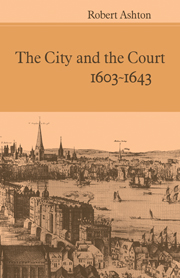Book contents
- Frontmatter
- Contents
- List of tables
- Preface and acknowledgements
- Note on dating, spelling and abbreviations
- Introduction
- 1 Institutions and oligarchy I: the municipal and business élites
- 2 Institutions and oligarchy II: gilds and companies
- 3 Big business and politics under James I
- 4 Big business and politics under Charles I
- 5 The crown and the municipality: local issues
- 6 The municipality and national issues
- 7 Conclusion
- Sources and bibliography
- Index
- Frontmatter
- Contents
- List of tables
- Preface and acknowledgements
- Note on dating, spelling and abbreviations
- Introduction
- 1 Institutions and oligarchy I: the municipal and business élites
- 2 Institutions and oligarchy II: gilds and companies
- 3 Big business and politics under James I
- 4 Big business and politics under Charles I
- 5 The crown and the municipality: local issues
- 6 The municipality and national issues
- 7 Conclusion
- Sources and bibliography
- Index
Summary
It is an established historical commonplace which finds regular expression in first-year-undergraduate and sixth-form essays that when the Long Parliament assembled in November 1640, the vast bulk of its members, including many who were ultimately to fight for the king in the Civil War, had been alienated from the existing régime of royal personal government, the dismantling of which over the succeeding months met with their complete approbation. Accordingly the central interest of the period of almost two years down to the outbreak of the war is correctly seen to reside in the need to explain the defection from the parliamentary cause of many of those who had opposed ship money and the centralizing tendencies of government in the 1630s, and who were delighted to get rid of Strafford and to vote for legislation which, while curtailing the royal prerogative and clipping the wings of the main instruments of the so-called eleven years' tyranny, ensured that parliament would be a regular feature of English constitutional life. Down to the recess in the autumn of 1641 the parliamentary reforms commanded very general approval. At the same time the king's concessions, albeit made under duress, fostered hopes of a new rapprochement between king and parliament. These hopes were shattered by the renewed offensive of Pym and his allies after the recess and a further and far less generally applauded assault on the prerogative.
- Type
- Chapter
- Information
- The City and the Court 1603-1643 , pp. 201 - 222Publisher: Cambridge University PressPrint publication year: 1979

